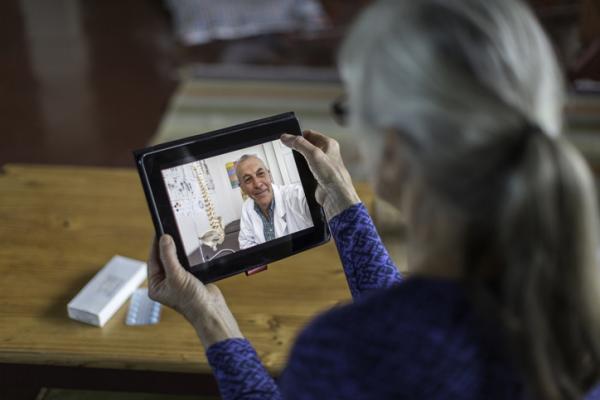
Courtesy Getty Images
November 19, 2021 — Telemedicine visits accounted for more than 60% of patient care at New York community health centers during the peak of the COVID-19 pandemic in spring 2020, finds a new study by researchers at NYU School of Global Public Health.
While video visits have their advantages, telephone visits accounted for a larger proportion of telemedicine care and are critical for providing access and addressing the “digital divide,” according to the study published in the Journal of the American Board of Family Medicine.
“Our study suggests that both video and phone visits will continue to shape how health care is delivered in a post-pandemic world,” said Ji Eun Chang, assistant professor of public health policy and management at NYU School of Global Public Health and the lead author of the study.
The COVID-19 pandemic has catalyzed profound transformations across the healthcare delivery system, including an abrupt shift toward telemedicine. While a significant amount of research has centered on the rapid adoption of telemedicine in the early weeks of the COVID-19 pandemic, less is known about the feasibility, use, and benefits of phone vs. video visits in the months following the widespread transition to remote care, particularly for “safety net” providers who care for vulnerable populations.
Chang and her colleagues tracked the use of telephone, video, and in-person visits across 36 New York community health centers from February to November 2020 and interviewed 25 primary care, behavioral health, and pediatric providers from eight community health centers about their experience with telemedicine during the pandemic.
Both types of visits increased significantly during the first wave of COVID-19 across New York State. At its peak (April 11– May 2, 2020), more than 60% of visits were conducted via telemedicine, the majority of which were provided via telephone. Telemedicine visits tapered off by the beginning of August 2020, accounting for less than 30% of visits. Telephone visits accounted for a larger proportion of telemedicine visits than did video visits throughout the period studied, but the gap narrowed over time.
The health care providers interviewed perceived telemedicine visits to be of similar quality to in-person visits and helpful in reducing no-shows. They also reported that telemedicine improved access to care for patients by providing flexibility; decreasing barriers such as transportation, childcare, and work-related time constraints; and reducing stigma surrounding mental health services.
Video telemedicine visits are often considered the “gold standard” alternative to face-to-face care because of the ability to see patients, which can provide useful clinical information as well as build rapport and improve patient-provider communication. The providers in the study expressed a strong preference for video visits but acknowledged that they may be exacerbating a “digital divide” between patient populations with more or less access to technology. Specifically, poor Wi-Fi connectivity, a lack of devices with video capabilities, and limited data plans were cited as constraints to successful video visits.
“When it comes to equity in health care access, telemedicine is a double-edged sword,” said Chang.
Telephone visits had unique benefits, including greater privacy, feasibility, and ease of use. Providers emphasized the need for both audio and video visits to remain reimbursable in order for providers to be able to provide ongoing support and care to patients.
“While the providers generally preferred video, they relied heavily on telephone as a lifeline,” added Chang.
The study participants also reported limitations of telemedicine, including difficulty conducting physical exams and inability to provide vaccines or other in-person care. They suggested ways to improve remote care, including making platforms more user-friendly for patients with low technology literacy, integrating them with electronic health records, and providing financial assistance for telemedicine, including funding for platforms for providers, home monitoring equipment such as blood pressure cuffs for patients, and training.
“Despite challenges, providers had positive experiences delivering care remotely using both telephone and video during the COVID-19 pandemic and believe both are critical for enabling access to care in the safety net,” said Chang. “The growth of telemedicine during the pandemic signifies a tectonic shift in health care delivery that is unlikely to be reversed.”
In addition to Chang, study authors include Zoe Lindenfeld and Donna Shelley of NYU School of Global Public Health and Stephanie L. Albert, Rachel Massar, Lorraine Kwok, Kayla Fennelly, and Carolyn A. Berry of NYU Grossman School of Medicine. The research was supported by the RCHN Community Health Foundation.
About the NYU School of Global Public Health
At the NYU School of Global Public Health (NYU GPH), we are preparing the next generation of public health pioneers with the critical thinking skills, acumen, and entrepreneurial approaches necessary to reinvent the public health paradigm. Devoted to employing a nontraditional, interdisciplinary model, NYU GPH aims to improve health worldwide through a unique blend of global public health studies, research, and practice. The school is located in the heart of New York City and extends to NYU's global network on six continents. Innovation is at the core of our ambitious approach, thinking and teaching.
For more information: http://publichealth.nyu.edu/
Related Telehealth Content:
California Physicians Weigh In On Telemedicine
Just Consider the Possibilities
4 Emerging Trends and Technologies in Teleradiology


 November 11, 2025
November 11, 2025 









